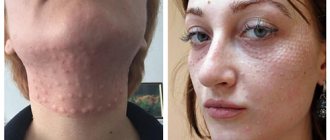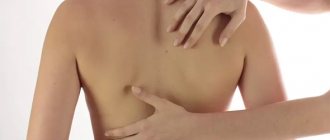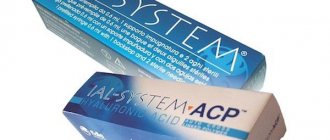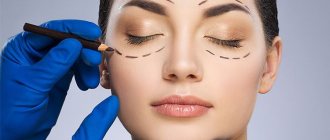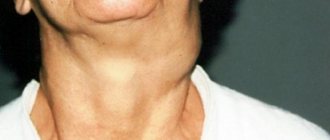Home > Urology > Pearly penile papules
- Treatment of prostatitis
- Pearly penile papules
- Fordyce granules
- Fordyce angiokeratomas
- Epidermal cysts
- Excision of the foreskin
- Short frenuloplasty
- Treatment of hydrocele
- Treatment of varicocele
- Removal of oleogranulomas
The Lazmed Clinic provides professional and virtually painless laser removal of pearlescent penile papules.
To achieve the most positive effect, the clinic’s specialists use modern laser equipment based on carbon dioxide (CO2) radiation in combination with the latest anesthetic drugs for greater patient comfort.
The procedure for removing pearlescent penile papules with a laser is the safest and most effective compared to other methods of treating this defect.
General information
Papular rashes are one of the common reasons for visiting dermatologists.
A papule (nodule) is an element of skin rashes, morphologically representing a cavityless, dense/soft on palpation formation, rising above the skin level, having a smooth/rough surface. A papule occurs as a result of the proliferation of skin tissue or due to the accumulation of cellular infiltrate/deposition of metabolic products (mainly cholesterol). The nodule refers to the primary elements of the rash, which occurs on unchanged skin and can in some cases transform into vesicles, pustules, and also increase in size and merge into plaques, combined with other elements of the skin rash. As a rule, the size of the papule can vary from 1 mm to 3 cm (Fig. below), and the color can range from white and yellow to gray and red (with inflammation).
Papules can be single or multiple, localized on any surface of the body. Papular rash can be a manifestation of a variety of processes. For example, papules on the face/neck, eyelids, and décolleté that appear after biorevitalization are a side effect of “rejuvenation” procedures based on the subcutaneous injection of hyaluronic acid . They are formed due to the administration and accumulation of the drug in the skin and, as a rule, last no more than 2-3 days (Fig. below). The rate of their resorption is determined by factors such as the thickness of the skin, the state of the lymphatic system, and the sensitivity/moisture of the skin.
Another example of a papule is the tuberculin diagnostic process (Mantoux reaction). What is a mantoux papule? Mantoux is a diagnostic test for tuberculosis , in which tuberculin is injected intradermally and after 72 hours the result is assessed: the absence of a papule/or its size does not exceed 1 mm indicates a negative reaction: the presence of a papule (up to 4 mm in diameter is a questionable reaction; a papule size 5 -16 mm – positive reaction).
The same principle is used to evaluate the result of Diaskintest , which is a new, much more specific/effective method for diagnosing tuberculosis . Unlike the Mantoux test, which is based on the introduction of tuberculin, the solution for Diaskintest contains synthetic proteins ESAT6/CFP10 characteristic of tuberculosis pathogens.
Also, a variant of the norm in men are pearly papules on the penis (pearly papules), which, according to various sources, occur in 10-40% of males, regardless of race. The papules are smooth, transparent, pink or white, 1-2 mm in diameter, and can completely/partially surround the glans penis (see photo of pearly papules on the glans penis below).
Pearly papules are benign angiofibromatous formations that are not prone to malignancy. Papules in men persist throughout life after their appearance and become less noticeable with age. Pearlescent papules do not require treatment and are not sexually transmitted. Currently, their appearance is considered as a cosmetic defect that can be removed if desired. Removal is carried out using electrodissection, CO2 laser, cryodestruction.
Much more often, a papular rash is one of the signs of both infectious diseases and dermatoses of viral, bacterial or parasitic etiology, and can also be a consequence of immunological reactions - allergies to medications, food, pollen, household chemicals, animal hair, house dust and etc. Rash elements in the form of papules occur in diseases such as measles , chicken pox , rubella , enterovirus infection , molluscum contagiosum and are accompanied by decreased appetite, chills, fever, pain in the abdomen/throat, indigestion, and headaches . Below we will consider diseases such as lymphomatoid and bowenoid papulosis .
Bowenoid papulosis is a sexually transmitted disease caused by HPV (human papillomavirus), manifesting as erythematous spots, papules or plaques in the anogenital area (genitals, perineum or thighs). The average age of patients is 31 years, and the high-risk group includes persons 17-40 years old, which is due to the high sexual activity of males and females during this period and promiscuity. No ethnic or gender differences were identified. The course is benign, often with spontaneous regression: Bowenoid papulosis can persist for a long period of time, however, in conditions of immunosuppression in elderly people, especially men, there is a risk of transformation into Bowen's disease / squamous cell carcinoma of the penis . Histologically, skin formations are sharply limited, exophytic tumors of the epidermis and irregular acanthotic cords are present. Atypical cells are scattered throughout the thickness of the stratified mature dermal epidermis.
Lymphomatoid papulosis
Lymphomatoid papulosis (LIP) refers to chronic primary lymphoproliferative skin diseases with histological signs of CD30+ lymphoma and a recurrent course (repeated eruptions of papular elements) that resolve spontaneously.
The incidence of LiP in the world varies between 1.2-1.9 cases/100 thousand population, occurs more often in men (1.5:1), occurs in all age categories (the age of onset of the disease is on average 35-45 years) . The course of LiP in most cases is chronic and benign, however, patients with LiP have a high risk of complications in the form of the development of secondary cutaneous/nodal lymphoproliferative diseases ( mycosis fungoides , Hodgkin's lymphoma , cutaneous large cell anaplastic lymphoma ). The frequency of development of such LiP-associated lymphomas, according to various authors, is 10-25% and can occur both simultaneously with it and after its onset, less often - precede it. There are several histological variants of LiP (types A, B, C and D), each of which is characterized by the presence of specific types of cells, but the course and prognosis do not differ.
Pearly papules on the head - how to treat?
As a rule, there is no need for treatment if the papules do not cause aesthetic discomfort to the man. For those who are concerned about the appearance of the penis, there are several treatment options:
- cryotherapy – removal of pearlescent papules using liquid nitrogen;
- laser surgery;
- electrocoagulation;
- cosmetic surgery.
The DAVINCI Clinic offers one of the most modern options - laser surgery. After a few days, a crust appears in place of the papules, which separates on its own over a period of time.
Full recovery after the procedure requires up to two weeks. During this period, it is recommended to exclude intimacy.
Classification
The classification of papules is based on a number of characterological characteristics.
According to the depth of placement, they are distinguished:
- Superficial papules (epidermal). Changes are noted only in the epidermis (flat papules with a diameter of up to 5 mm - flat warts without pain).
- Deep papules (epidermal-dermal) changes are noted between the layers of the epidermis and dermis. When pressed, there is a painful sensation and dermal (changes within the dermis).
By papules size:
- miliary (1–2 mm in diameter, cone-shaped);
- lenticular (size – 5–10 mm, have a rounded flat shape);
- nummular papules (reach a size of up to 2 cm, form independently or as a result of the fusion of small papules);
- plaques (diameter more than 20 mm, formed as a result of fusion.
The nature:
- non-inflammatory papules are formed due to increased proliferation of epidermal/dermal cells.
- inflammatory papules are formed as a result of local dilation of blood vessels, as well as cells of the immune system, the immigration of which is caused by inducers of inflammation.
Signs
Pearlescent papules form unnoticeably. Their appearance is not accompanied by itching or inflammation. The color matches the skin, maybe a little lighter. The surface is matte-shiny, reminiscent of mother-of-pearl. The heads are located along the crown in 1 or 2 rows. Such pearlescent nodules are painless when pressed, soft, and nothing stands out from them. There is no cavity or liquid content inside, so it is useless to squeeze them out - blood will flow, but the formation will remain in place.
Papular rashes are often confused with papillomas, but the latter are usually solitary, look like lumps of skin, and can be pedunculated or without it. Sometimes they are located in an area characteristic of pearlescent papules. White bumps on the penis can also be Fordyce granules. These are safe cystic formations. On top they are soft, filled with liquid, and below there is a dense yellowish lump of fat that clogs the gland.
Papillomas on the penis – https://prntscr.com/uwkwja.
What are pearlescent papules and what they look like, says urologist Ekaterina Aleksandrovna Makarova
Causes
Bowenoid papulosis . The disease is caused by activation of HPV types 33, 31, 18 and 16, less commonly types 35,39,48,51-54. It is transmitted predominantly through sexual contact, autoinoculation is possible, and infection of a newborn from the mother is extremely rare. The incubation period varies from 2 months to many years.
Lymphomatoid papulosis . The specific cause of lymphomatoid papulosis is currently unknown. There is an assumption that LiP is a manifestation of the immune response to antigens unknown to science, which have relatively little immunogenicity. Another assumption is a viral etiology (herpes virus type 6, human T-lymphotropic virus, Epstein-Barr virus). The disease can also be provoked by prolonged exposure to allergens on the human body, which form a delayed-type hypersensitivity reaction and contribute to the development of a dysregulatory effect.
Traditional treatment
Pearlescent nodules do not cause any harm to a man’s health, so removal is carried out only for cosmetic purposes. In some cases, hormonal therapy is used in combination with vitamins. All medications are prescribed only by highly specialized specialists. The selection of medication and dosage occurs individually.
The main problem with having nodules is discomfort due to tightness, which can sometimes cause certain difficulties in bed. Psycho-emotional disorders cause sexual dysfunction.
Currently, there are no drugs for treatment (ointments or creams) in pharmacology. But there are many folk recipes that help get rid of papules. Popular substances used in creating remedies for nodules on the head:
- Oil. Both essential and herbal are used.
- Waste products of various animals and insects.
- Medicinal plants.
At present, no one can say for sure that such recipes help. Using traditional methods for treatment is a very long process that requires responsibility.
For example, an ointment made from sea buckthorn oil, honey and mumiyo (everything is mixed in equal proportions) reduces the size of the bubbles, according to those who have tested it. This product must be used for 15 days. The course of treatment is repeated 4 times at certain intervals.
It should be remembered that some substances included in homemade medicines can cause allergies or chemical burns, so it is important to discuss everything with a dermatologist.
Symptoms
Bowenoid papulosis
The disease manifests itself in the anogenital area of multiple papules with a diameter of about 2-3 mm of brown, red or flesh color, which in the later stages can merge into plaques. There are several types of bowenous papules: erythematous macules (pigmented papules), lichenoid (lichenoid), leukoplakia-like (milky gray/white). Visually, lichenoid papules are similar to a warty formation with an intense red-brown color. Fused papules form plaques, which stand out sharply against the background of healthy areas of the skin and have a transparent milky color.
At the same time, pigmented round papules are localized mainly on the body of the penis, less often on the pubis, and lichenoid papules are usually localized on the glans penis. Papulosis in women manifests itself predominantly as pigmented papules, and the most common localization is the clitoris and labia minora/major. With extragenital localization, round papules may appear on the pubis and penis, as well as the scrotum in men; in women they more often appear in the perineum, inguinal folds, and perianal area. From time to time, patients may complain of mild itching in the area where the papulosis elements are located, and with inflammation, pain. Below are photos of bowenoid papulosis in women.
Lymphomatoid papulosis
It is benign and has a chronic course. The disease manifests itself with asymptomatic rashes (papules) mainly on the skin with a diameter of 2 to 30 mm in quantities ranging from several pieces to several hundred. Most often, lesions are localized on the trunk/limbs, less often on the scalp and face. Elements of the rash appear in waves, tend to group, are capable of self-resolution, the development of hemorrhages, ulceration/necrosis and repeated rashes. As hyperkeratosis , scales appear.
The life cycle of rash elements is 2-8 weeks. Papules can become covered with hemorrhagic crusts, scratching is possible, and a secondary infection often occurs. Elements of the rash can involute independently at any stage. As a rule, the resolution process begins from the center of the papule and ends with the formation of an atrophic scar, which is accompanied by hyper/hypopigmentation. The patient's general condition does not suffer; in rare cases, itching and prodromal phenomena are possible.
Removal of pearlescent papules at the DAVINCI CDC
Experienced specialists at the DAVINCI clinic conduct a full examination and prescribe a suitable method for removing pearlescent papules. Our center in Rostov-on-Don is equipped with modern devices that ensure high-quality and safe procedures. We use certified drugs.
Qualified urologists have extensive experience in performing operations to remove skin tumors. An individual treatment plan is selected for each patient and the necessary procedures are prescribed.
Make an appointment by phone so you don’t have to wait in line and get in for a consultation right away. Our operators will answer your questions and refer you to the appropriate specialist.
- Name of service
Price
- Appointment with urologist-andrologist N.E. Avadieva
2200 rub.
- Removal of pearly papules (without anesthesia)
8000 rub.
Tests and diagnostics
The diagnosis of bowenoid papulosis is made on the basis of examination, patient complaints, acetotest and cytological and histological examination data. To identify the type of papillomavirus, a PRC study is performed. Differential diagnosis is carried out with syphilitic papules , lichen planus , Queyre's erythroplasia , genital warts , angiokeratomas , warts , epidermoid cysts .
The diagnosis of CD30+ LiP is established by assessing the characteristic clinical picture and immunophenotypic/histological examination of biopsies obtained from skin lesions.
Modern help
If you decide to remove the necklace, you should consult a doctor. There are several methods, and each has its own characteristics. The most suitable option is selected only after undergoing a thorough examination. You also first need to exclude possible contraindications to the operation.
For removal use:
- Laser therapy. With this method, anesthesia is not required. Papules or parts thereof are vaporized using a focused beam. On average, the cost of the procedure is 400 rubles per bottle. Contraindication is the presence of oncology.
- A liquid nitrogen. The neoplasm is exposed to extreme cold. This procedure has almost no side effects. The approximate price is 9,000 rubles.
- Electrocoagulation. Using an electrode, each growth is burned out individually. All residual elements (if any) are removed manually. Judging by the reviews, the method is absolutely useless.
Removal using a regular scalpel is also used. This method requires a long rehabilitation period. The entire procedure takes about an hour, and after completion the patient can immediately go home. Recovery occurs in approximately 10-15 days. During this period, you need to regularly treat the surgical area with an antiseptic and maintain sexual rest. As a supplement, vitamin complexes and restorative drugs are prescribed. It should be remembered that the probability of relapse is 65%, and preventive measures have not been established to date.
List of sources
- Dermatovenerology. National leadership. Ed. Yu. K. Skripkina, Yu. S. Butova, O. L. Ivanova. – M.: GEOTAR-Media, 2011. – 1024 p.
- Chernyshov P.V. Pearly penile papules//Ukrainian Journal of Dermatology, Venereology, Cosmetology. – 2011 – No. 3 (42). pp. 100-103
- Lezvinskaya E.M., Vavilov A.M. Lymphoproliferative tumors of the skin. Guide for doctors. M.: Practical medicine; 2010: 134-92.
- Olisova O.Yu., Savelyeva S.V., Sitnikova E.V., Kabaeva T.I. Modern view of lymphomatoid papulosis. Russian Journal of Skin and Venereal Diseases. 2000; 6:8-11.
- Vasiliev M.M. Modern aspects of papillomavirus infection of the urogenital tract (Clinic, diagnosis, treatment) / M.M. Vasiliev, I.I. Bogatyreva, L.K. Kotova [and others] - TsNIKVI Ministry of Health of the Russian Federation Moscow. — 2004 — 158 p.
Why choose us
- KNOWLEDGE, EXPERIENCE AND QUALIFICATIONS All doctors regularly undergo training in leading Russian and foreign clinics and events
- OWN LABORATORY Performing analyzes in the shortest possible time at affordable prices.
- TECHNICAL EQUIPMENT The rooms are equipped with modern equipment from the world's leading manufacturers
- PIONEERS AND INNOVators We are the first to introduce many modern technologies in Rostov-on-Don. (5D ultrasound, aesthetic gynecology and anrology, photodynamic therapy, radiothermometry, vacuum aspiration biopsy, Fotona4D)
Reviews about us on Flamp

